The Annapurna Circuit was my fourth major trek, three of which had taken place in Nepal. I was finally starting to feel like I had the hang of this whole trekking thing, but there was one thing I still had yet to do, and it made me feel like I wasn’t a “real trekker.” I had never actually carried my own bag. For every trek, I’d always had a strong sturdy porter who lugged the majority of my things up the mountain. I always overpacked knowing I didn’t have to carry everything. Creating the perfect Annapurna Circuit packing list took a lot of research and some trial and error.
In Nepal, being a porter is a stepping stone to be a guide. So, I also felt like hiring a young man was giving him the opportunity to support his family in between sessions at school. Regardless, I’d always wanted to attempt to carry my own luggage, and the Annapurna Circuit seemed like the perfect opportunity. You’ll find that this list is small. As I went, I ended up leaving items along the way. I’d also recommend thinking about every single tiny bit of weight because let me tell you, the easy days felt so much harder simply because of my backpack.
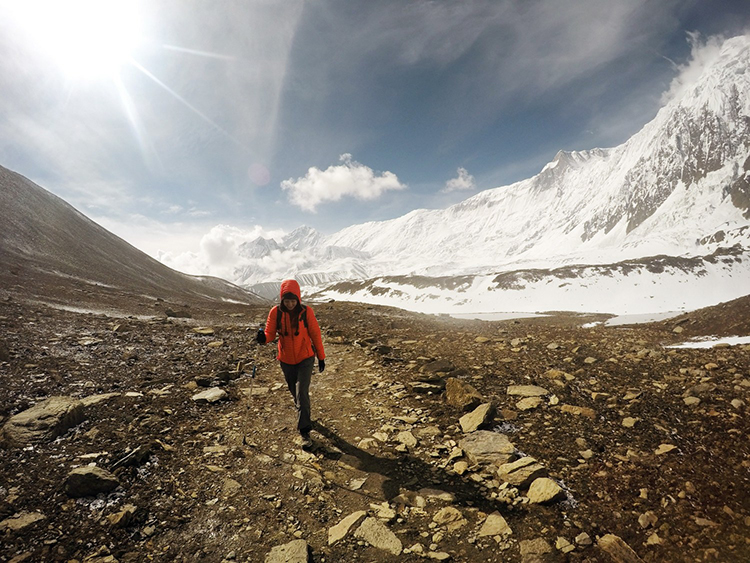
Backpack & Storage for the Annapurna Circuit
40L Backpack
I have the 40L Alchemist Bag from Eddie Bauer. It’s water resistant, has a tough outer shell that doesn’t rip easily, and is big enough to hold everything I need for a 4-15 day trek. I don’t recommend taking a bag over 55L because typically when you have more room, you fill it up with unnecessary stuff.
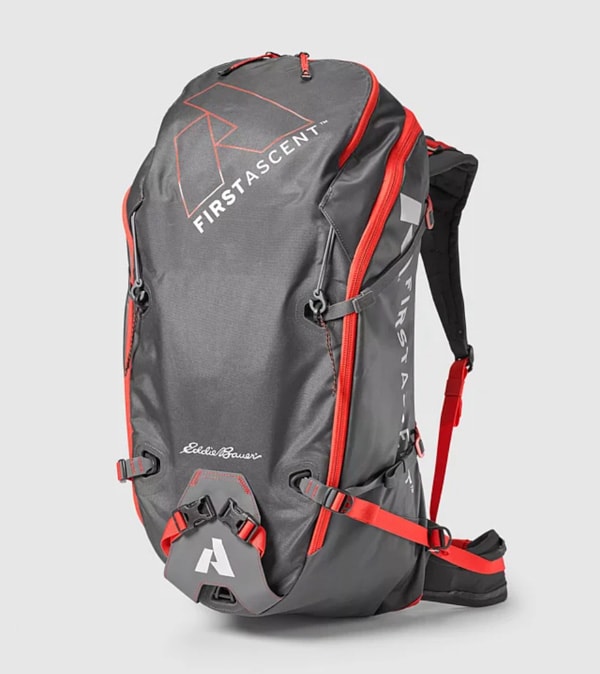
Mudder Waterproof Bags
Even though my bag is water resistant, it will get wet in a downpour, so I always have waterproof bags to store electronics and important documents like my insurance papers and wallet.
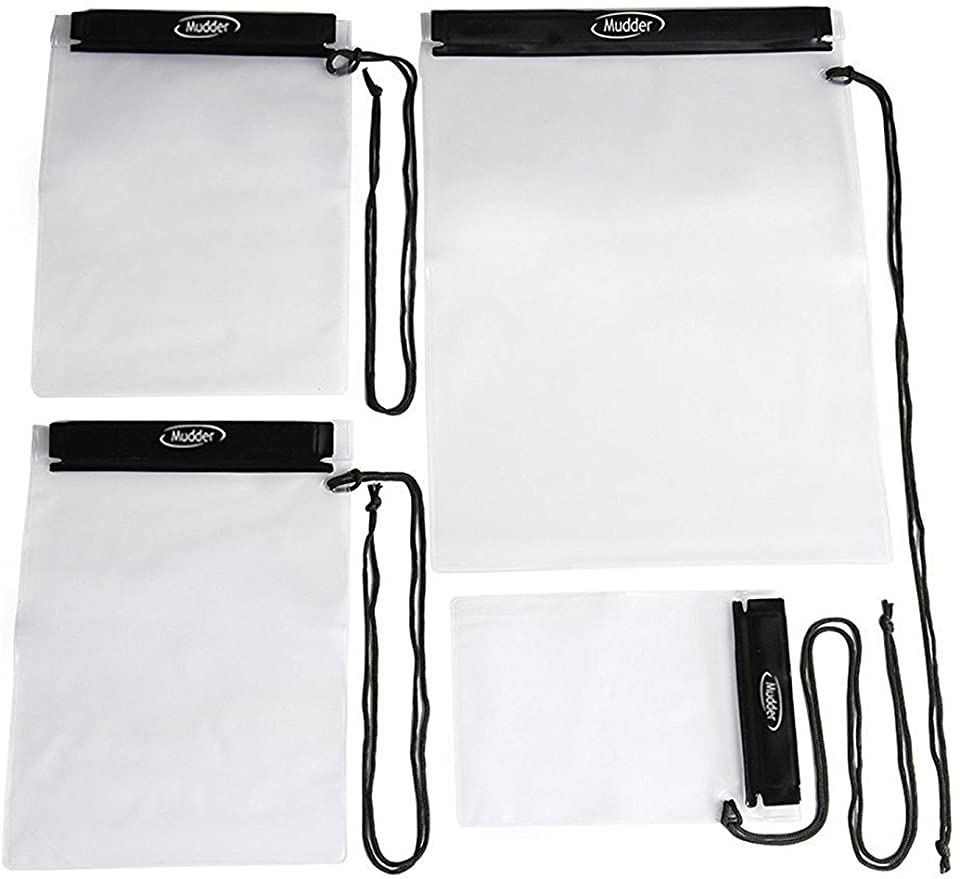
Packing Cubes
I’m a huge fan of packing cubes and can’t live without them. When trekking, you need to unpack and pack every day in a room without a dresser or table. Therefore, having everything in neat little cubes makes it easier. You just take out the cube you need rather than unpacking every single item in your bag.
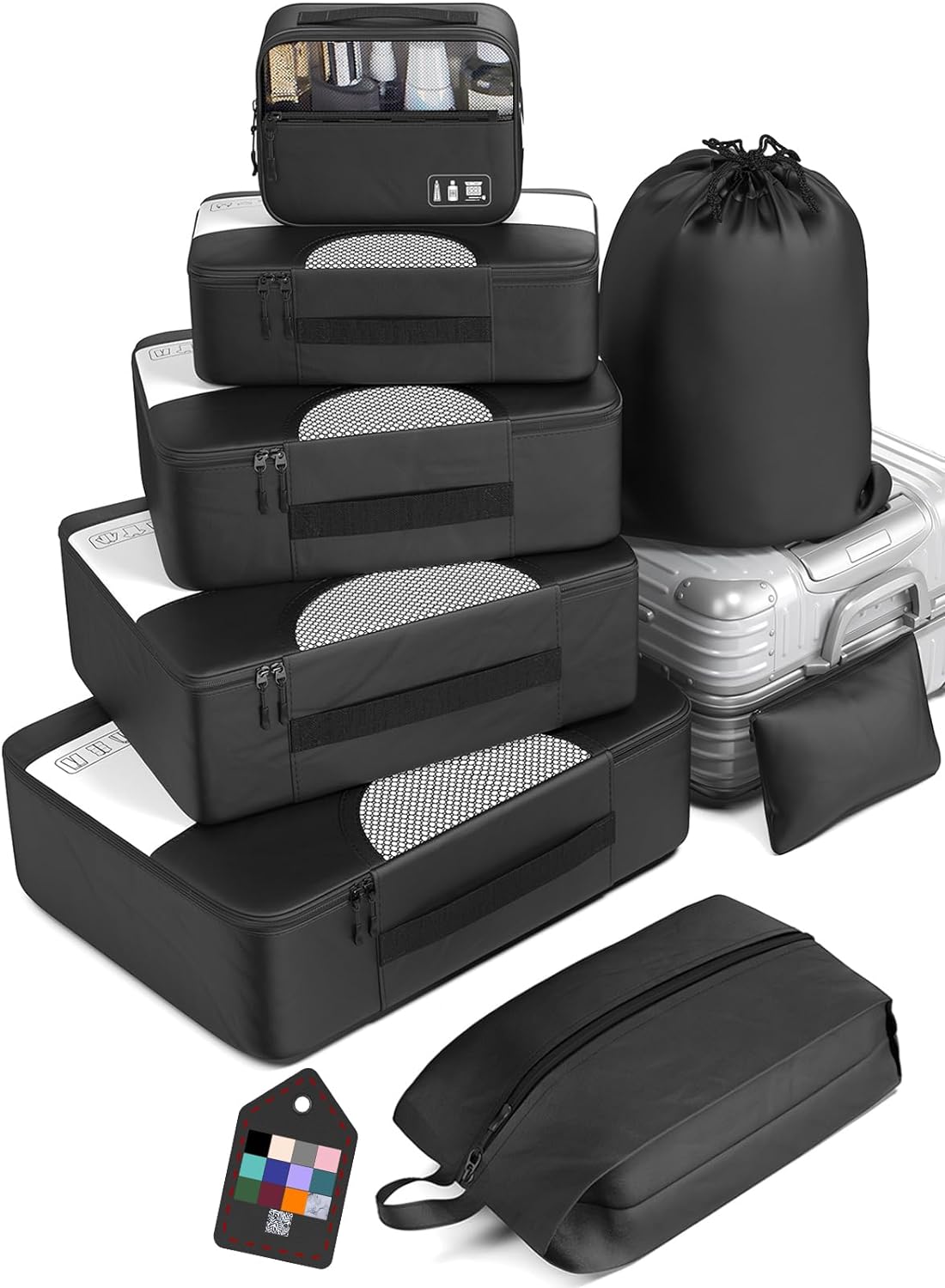
Water Bottles
Single use plastic water bottles are bad for the environment, and have been banned in the Annapurna Conservation Area. Please bring a reusable water bottle and a water purification method to help reduce waste in the mountains.
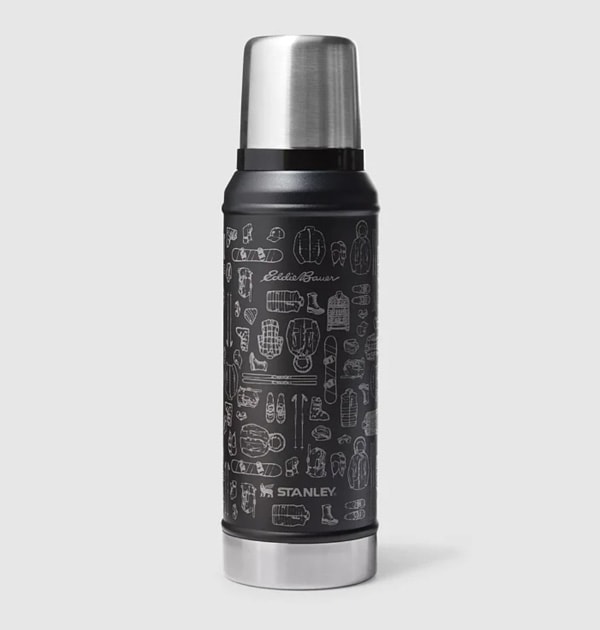
Backpack Rain Cover
This is a must if your backpack isn’t waterproof. Many backpacks are water resistant but won’t stay dry in a downpour.
Plastic Bag for Laundry
I bring a simple grocery store plastic bag for laundry to keep it separate from my other clothes. I only put dirty underwear in it as the larger items like pants and shirts will be worn more than once. A plastic bag adds no weight and doesn’t take up any room.
Ziplock Bags
Never underestimate the ziplock bag. These come in handy more often than you would think.
Annapurna Circuit Clothing & Accessories
When I started trekking, I purchased cheap knock offs in Kathmandu. Over time, I’ve invested in good quality trekking gear and clothing. My favorite brand is Eddie Bauer, so I’ll mostly be referring to them below. I find the quality of their clothing to be a lot better than other companies, and I usually buy things when they have a 40-60% off sale (these happen fairly often). That way I’m able to get everything for a great price. Here’s the clothes you should have when planning your Annapurna Circuit packing list.
Down Coat
I was a little worried this coat wouldn’t be warm enough because it’s so thin that it zippers up into its own pocket. But, it’s one of the warmest coats I’ve ever had. I’ve had so many people ask me about my coat, and it’s become my “signature look” since I’m wearing it in nearly all my photos haha.
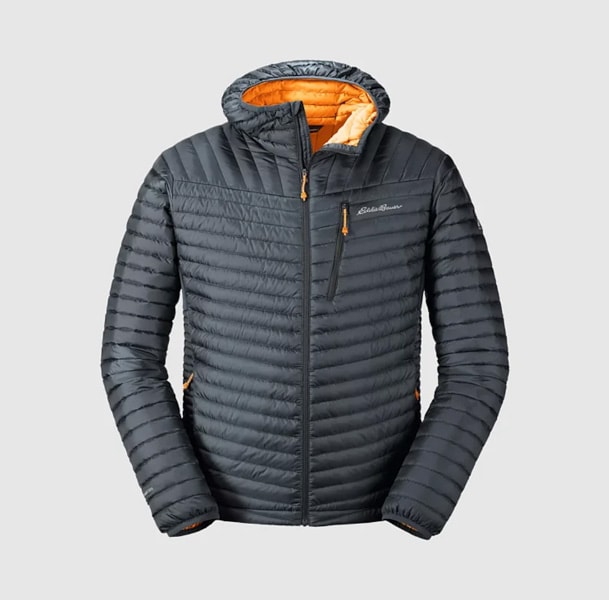
Fleece Zip-up
I wear my fleece constantly while trekking. I like to put it on whenever I stop for a tea break because my body cools down as soon as I stop walking. It’s great for nights in the teahouse and for sleeping. It’s also perfect for layering on the coldest days.
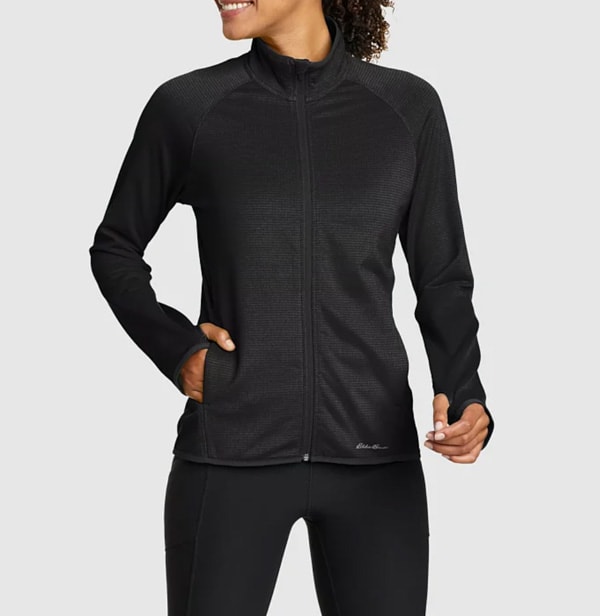
Rain Jacket
A rain jacket is important. I prefer mine to be a little big so that I can layer it over my down coat if necessary. I have this Eddie Bauer raincoat and love it. Many people prefer a simple poncho which also works.
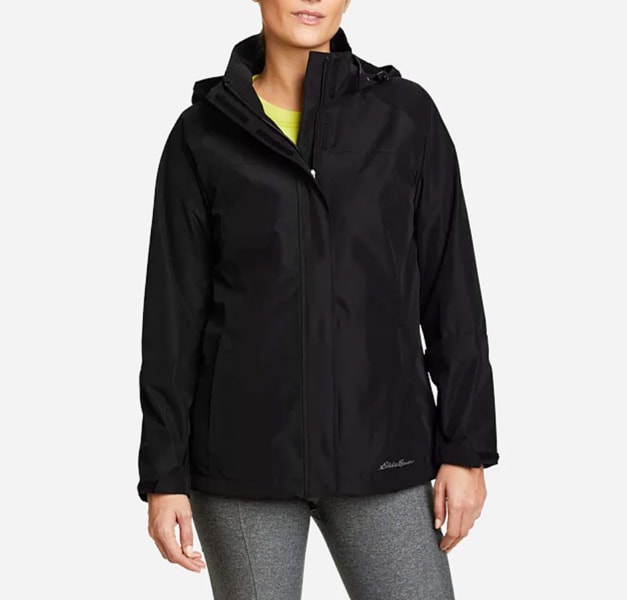
2 Quick Dry T-shirts
I like to have two t-shirts so that I can wash one while I wear the other. Quick dry fabric is important because I tend to sweat a lot when my pack is on, and my back gets wet. If it doesn’t dry quickly, then I get a chill. It’s also handy for doing laundry since the shirt will dry quicker when you’re done.
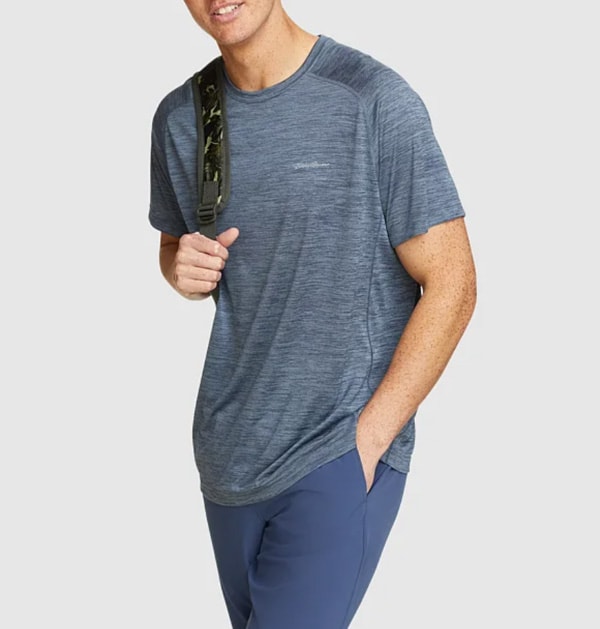
Quick Dry Long Sleeve Shirt
Again, I prefer quick dry shirts. I like to have one long sleeve for the days at higher altitude.
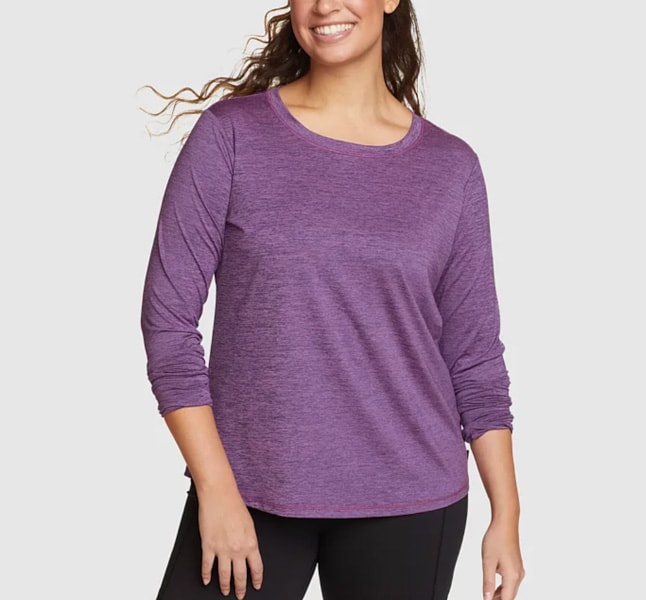
2 Hiking Pants
I love these pants for hot days. They’re super lightweight and comfortable. They’re also cute which seems to be rare in hiking pants.
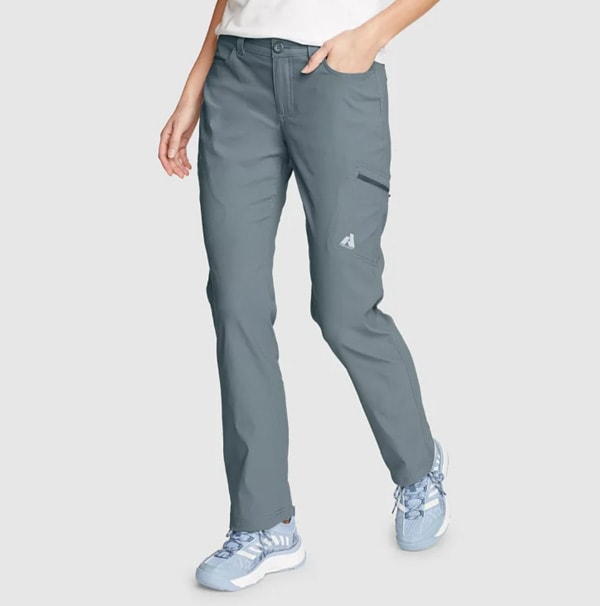
Thermal Top & Bottom
Thermals are so important on this trek. There’s no heat in the bedrooms of teahouses, so I wear mine to bed at night. They’re also great for the days when you trek before sunrise.
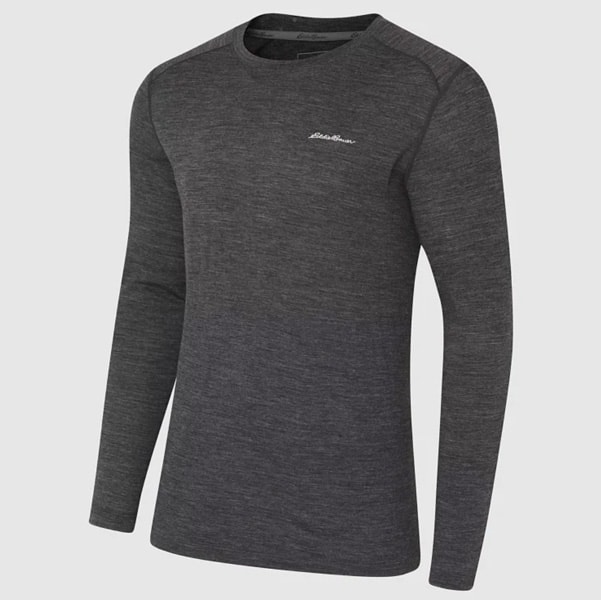
Buff / Scarf
Having a buff is crucial. There are some dusty areas on this hike, and it’s great on cold days. I also wore mine to bed at altitude to keep my neck warm.
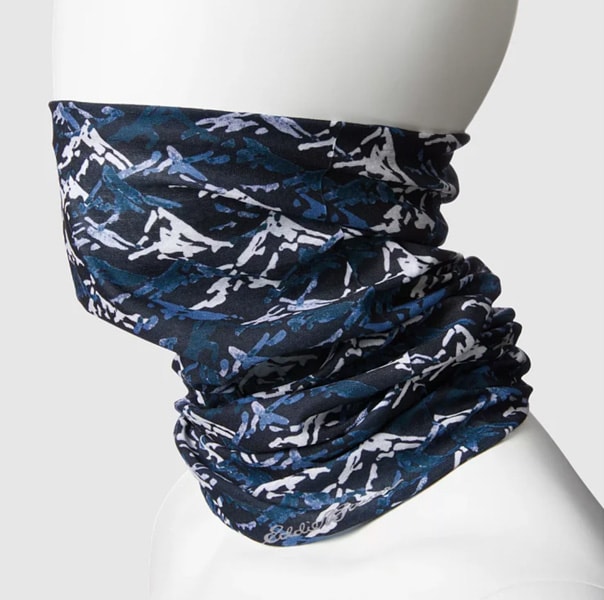
3 Ankle Socks
I rotate two ankle socks for daytime use and keep one separate to sleep in, that way they don’t smell.
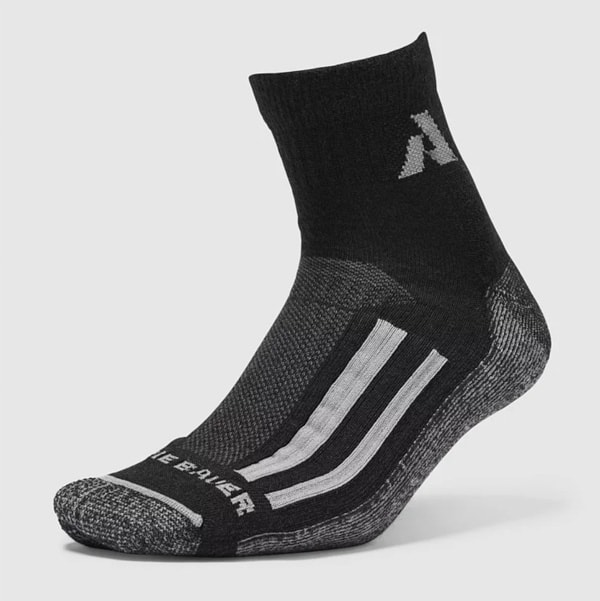
Long Socks
I only wore these on the coldest days or days when we trekked before sunrise. For instance, going to Tilicho Lake Base Camp or going over the pass.
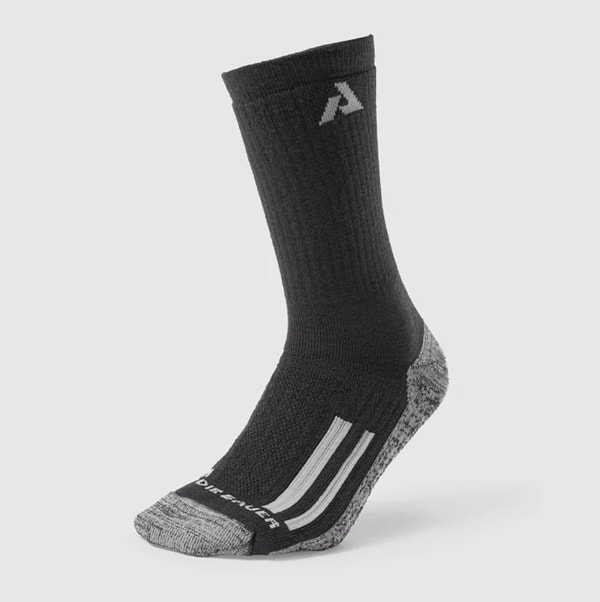
Hiking Boots
It took me a while to invest in a great pair of hiking boots because they aren’t cheap, but I really love these. They have good grip and great ankle support. I’m super clumsy, so those things are important to me. I bought them on sale at REI so they were $160, and I’m part of the co-op so I’ll get some money back at the end of the year. I know they’ll last a long time and get a lot of use, so for me it was worth buying a high quality pair.
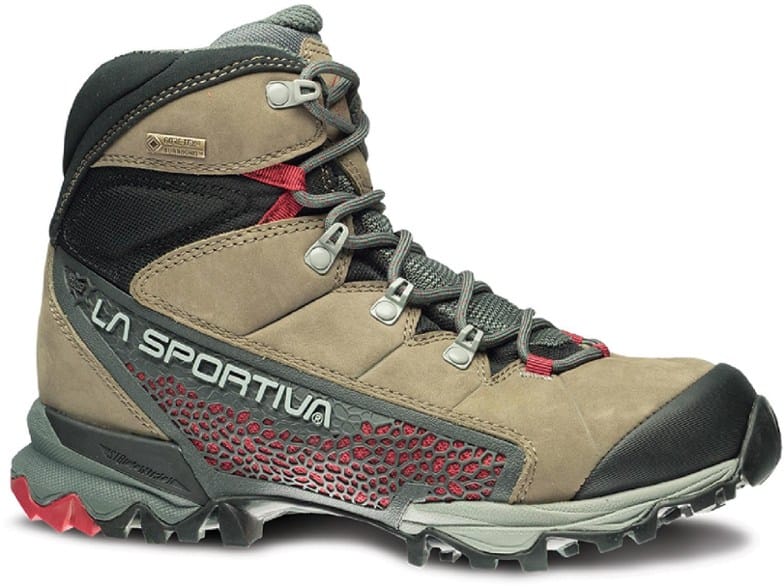
Hiking Sneakers
If you are just starting out with your hiking journey and you’re not ready to spend $200-$300 on boots, then I’d recommend getting a boot/sneaker hybrid. The first two treks I did, I had a hybrid shoe and it was great. It’s also a fantastic option if you’re backpacking and want a shoe that can be for hiking or normal walks through cities. I was recently gifted the NORTIV 8 hiking sneakers and love them. They’re a great affordable option.
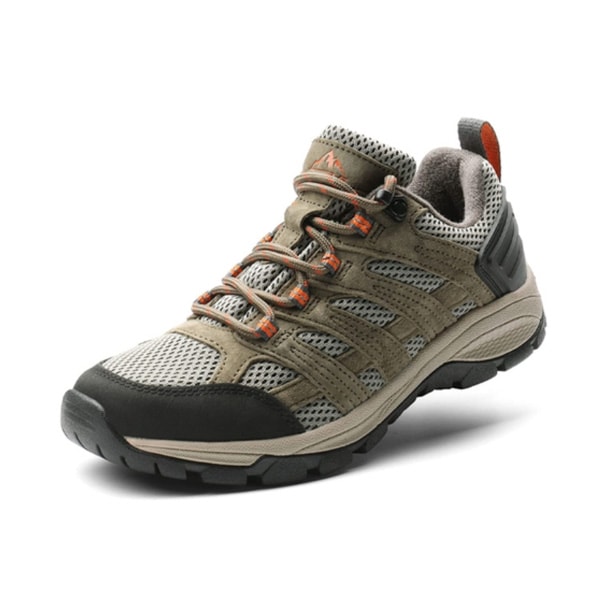
Flip Flops
There are several places to take showers on this trek, so these are great for shower shoes. I also wore them in the teahouses. It’s nice to have something to slip into besides your boots and they aren’t heavy in your bag.
Summer Hat
I recommend a moisture-wicking hat with UV protection if possible. If you use a normal baseball cap, it will end up extremely sweaty.
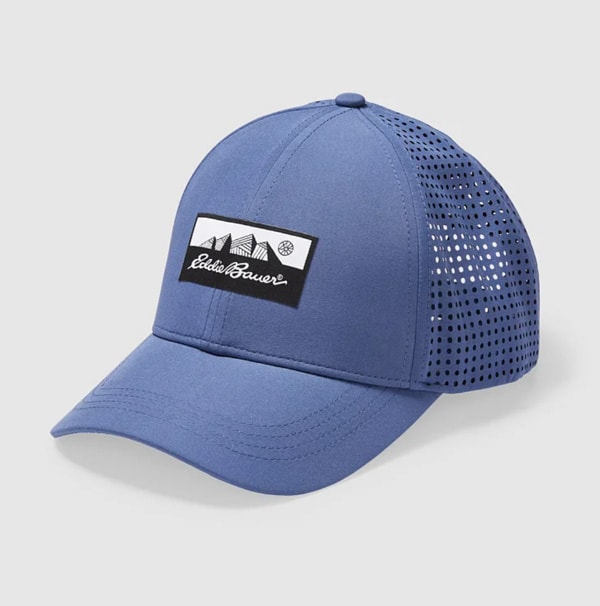
Winter Hat
Make sure to choose a warm and well-fitting hat. It gets windy up high so you want one that’s snug on your head.
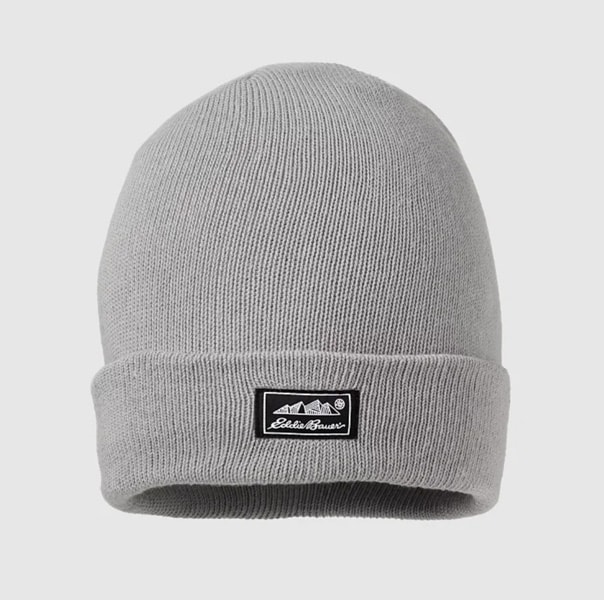
Polarized Sunglasses
You should definitely have polarized sunglasses. Snow blindness is a real thing, so this is important.
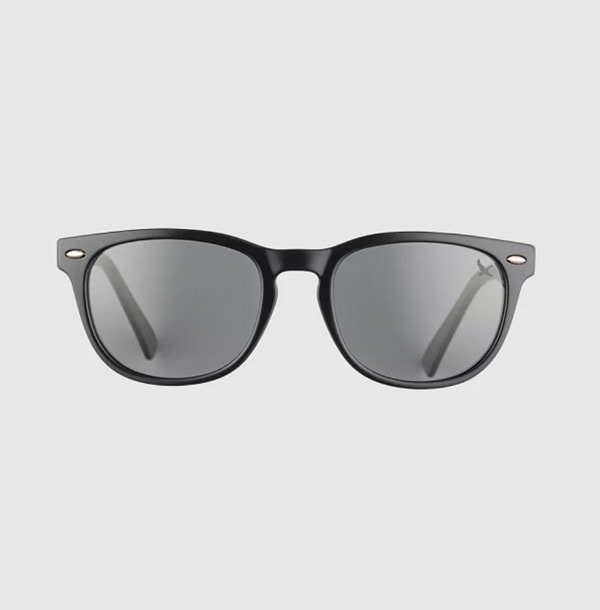
Gloves
Early morning hikes and high altitude days will require gloves. A few girls I was with didn’t have any and their fingers were freezing. Frost bite can happen on this trek if you’re careless.
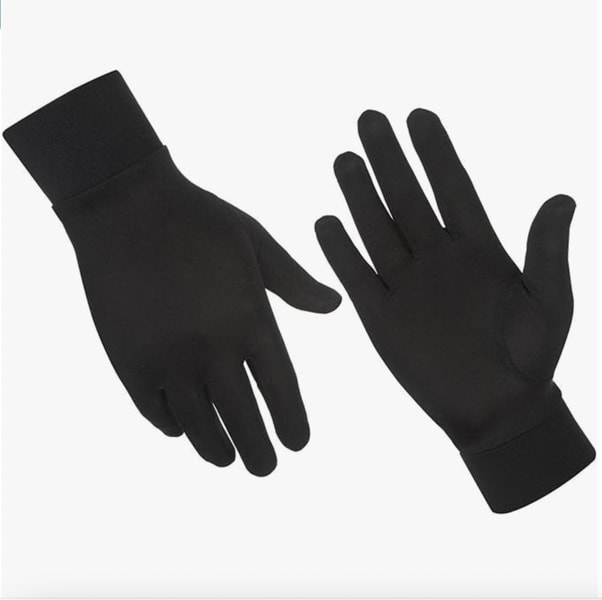
Pajamas
Lightweight pants/ leggings and a long sleeve shirt are usually fine. I wore thermals at altitude when it was cold. If you go in warmer months like May, you might want a short sleeve shirt instead.
8 Underwear
I always bring extra underwear. I know some people just bring three or four pairs and wash them constantly. I find it hard to wash underwear while trekking. If they don’t dry before it gets dark then you have to hang them from your bag to dry the next day and that’s not always acceptable. I carry extra and wash them on acclimation days when I know we’ll be staying put.
2 Sports Bras
I treat sports bras the same way I do t-shirts. Wash one while you wear the other.
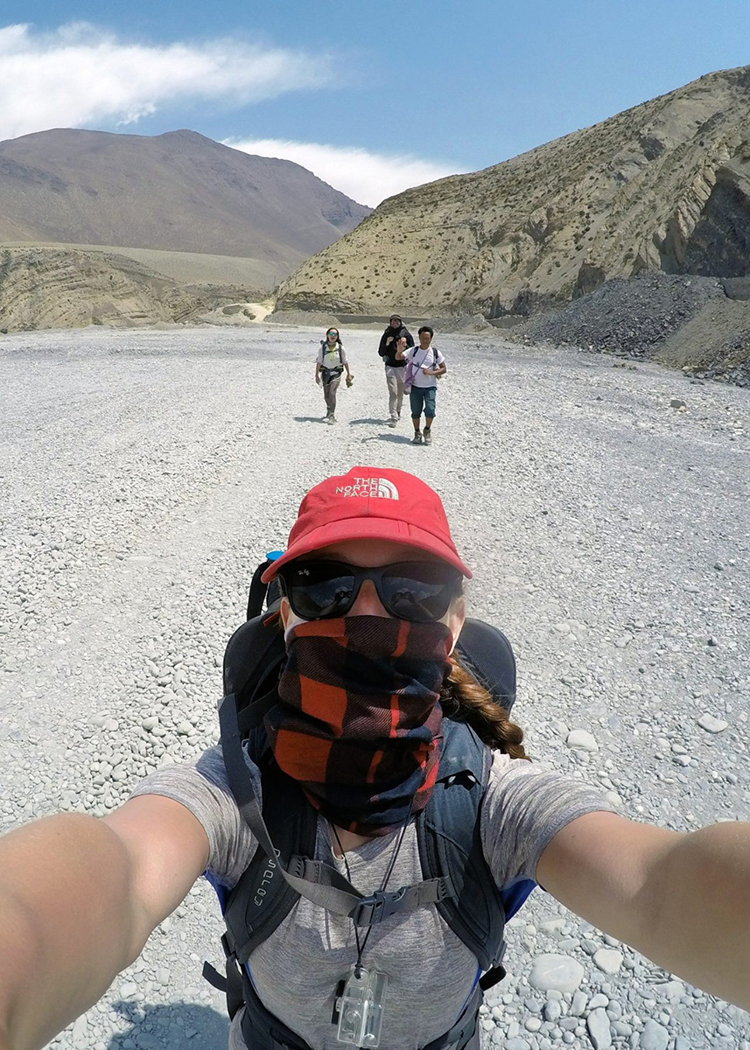
Toiletries
I started out with a travel size shampoo and conditioner. After two days, I left them behind. I was able to buy small individual packets of shampoo along the way, so I didn’t have to carry anything extra. Make sure everything you bring is small and travel sized. I wish I brought a lightweight comb instead of a heavy hairbrush. A tiny toothbrush and toothpaste are also good. The smaller and lighter the better when planning your Annapurna Circuit packing list.
Wet Wipes
Some days you can’t find access to showers or it’s too cold to shower and there’s no hot water. Wet wipe showers are a great alternative. These are biodegradable which I like since garbage disposal on the trek isn’t great.
Quick Dry Towel
A small microfiber towel is a must if you plan to shower on the way. These dry incredibly fast and pack into a small space.
Bug Repellent
I like Badger Bug Balm which is a natural bug repellent. It’s a solid stick, so it won’t spill in your bag and it works very well!
Sunscreen
I’ve seen so many people coming down from the mountains looking like lobsters. The sun is STRONG at altitude. Buy a good quality SPF 50 sweat proof sunscreen.
Tooth Care
Bring a small travel sized tube of toothpaste, a travel sized toothbrush and floss.
Hand Sanitizer
Hand soap isn’t always available, so having a way to clean up is key.
Deodorant
Pack a small travel sized deodorant.
Vaseline
A mini vaseline is important for windy cold days. Put it on in the morning before going trekking. I didn’t do this on one trek and got wind burn on my face ouch.
Roll of Toilet Paper
Pack 1 roll at the beginning of the trek and then buy more as you go. You won’t find toilet paper in the teahouse bathrooms. It’s important to bring your own.
Feminine Hygiene
It’s hard to find pads in the mountain and impossible to find tampons in Nepal, so bring what you need with you. I’m usually a big supporter of Diva cups, but it’s hard to wash them properly on trekking routes.
Hair Care
Bring hair ties and a lightweight travel hairbrush (or comb). Don’t make the mistake of packing a heavy brush.
Shower Supplies
Bring a small travel sized bottle of shampoo, conditioner, and shower gel. If you bring soap, make sure to have a plastic zip lock bag to store it in after using it. I also recommend a nail clipper or nail file.
Laundry Detergent
Bring a ziplock bag with some powdered detergent in it. This is a long trek and you’ll likely want to wash your clothes every so often. Try to choose an environmentally friendly detergent.
Nail Clipper
Pretty self explanatory, but make sure to get the kind with the little thing that cleans under your nails. Without a place to wash your hands properly, you’ll get a lot of dirt under there.
Fabric Softener Sheets
I brought fabric softener sheets from home. I put them in with my clean clothes and laundry to make sure everything stayed smelling fresh over during the trek. They definitely made a difference.
First Aid & Medicine
Unfortunately, you never know what you might need, so it’s best to carry a little bit of everything. My best advice is not to take full bottles or boxes of medicine. Just take out what you need, and put it in a small Zip Lock bag. That way you don’t have the weight of the packaging or an entire bottle of pills when you’ll only need ten. I’d recommend putting all of these on your Annapurna Circuit packing list, just in case.
Diarrhea Medicine
Traveler’s diarrhea is very common in Nepal. I always have pills in my bag just in case.
Activated Charcoal
This is known to cut down the recovery time of food poisoning. Note it can affect and negate other medication, so ask your doctor if it will interfere with any prescriptions you take.
Electrolytes
Staying hydrated at altitude is difficult. You have to drink 3L of water a day. These are great in case you feel dehydrated.
Ankle / Knee Support
I have a bad knee and ankle so I use a brace for the downhill sections. This makes my life exponentially easier and helps manage the pain.
Basic First Aid
Have an array of items including band aids, Neosporin, antibacterial creams, etc. On our last trek, Suraj slipped on a wet rock and got a big gash in his knee. Luckily, I had gauze, antibacterial powder, a large band-aid, and some medical tape to fix him up.
Water Purification Tablets
Water isn’t potable in Nepal, so you need to have a filtration system. This is the cheapest and lightest way to have clean drinking water.
Vitamins
I bring several immune boosting vitamins with me including Airborne chewables, a gummy probiotic (because they don’t have to be refrigerated like most probiotics), olive leaf, zinc, etc. I also bring a cold medicine and pain killer like Tylenol just in case.
Antibiotics
There are no western hospitals on the trek. I always carry a high-grade antibiotic in case of an emergency. Ask you doctor when to use it.
Prescription Drugs
There are almost no pharmacies in the mountains, so be sure to have all prescription drugs with you when you head out.
Cold Medicine
I got a nasty cold on my first major trek and it sucked. Having cold medicine was a life saver. Do not use nighttime medicine at high altitudes as they can affect your breathing which is already affected by low oxygen levels in the air.
Tylenol/Advil
Sore muscles can get intense, having a pain-killer is helpful if you have any back or knee problems. I never use mine, but I like having them for an emergency.
Diamox
I’ve done over 10 treks in Nepal and have only taken Diamox once. If you don’t plan to take Diamox, bring some with you for emergencies. If you are considering taking it, talk to a doctor to make sure it’s right for you. There are side effects and you need to drink a ton of water when taking it.
Throat Lozenges
Throat lozenges are a life saver, especially if it’s cold when you go trekking. Teahouse walls are super thin, so waking up and coughing means you wake up the whole teahouse. They’re also great during the day if the air gets cold. These are more important in colder high altitude areas, but are also handy if you get sick and have a sore throat.
Electronics
I would bring the bare minimum for electronics. Most tea houses have outlets and will let you charge things for free. Therefore, you don’t need anything excessive like a solar panel. We did hit a chunk of the circuit that had lost power for over a month and my power bank (although heavy) came in handy. I would advise asking people who just returned from the trek what the electricity situation is that way you can plan your Annapurna Circuit packing list accordingly.
Cell Phone & Charger
I always bring my cell phone. Sometimes there’s a little bit of service and I like to check in with family when I can. There’s also wifi on this route.
Camera, Charger, & Spare Batteries
I did a slow version of this trek which took 30 days, so I refused to carry a giant camera. I take a GoPro to keep things light and compact.
Travel Adapter
You” likely need an adapter to charge things. This one is lightweight compared to chunkier options.
SIM Card
I’d recommend a Namaste SIM since it seems to get better data in the mountains. Some hotels charged $1.00 for WiFi, so having a data plan will end up being cheaper if you really want to stay connected. You can read my post about SIM cards in Nepal.
Maps.me Downloaded
Maps.me is a free phone app that has all the trekking trails on it. This is great as a backup if you get lost. Make sure to download it before starting the trek as you need a good wifi signal to download the map.
Headlamp
Power outages are common and there’s often no electricity at night. You’ll need this to go to the toilet.
Kindle
I refuse to carry books. I like that the kindle has a back light and is easy to read. It also holds a charge for a long time.
Power Bank
On some routes you’ll need to pay to charge a device. It can cost between $1.00 to $3.00 USD per charge and there may be limited outlets available and a queue. It’s best if you have a power bank because you can charge that one time and then use it to charge all your other devices for a few days.
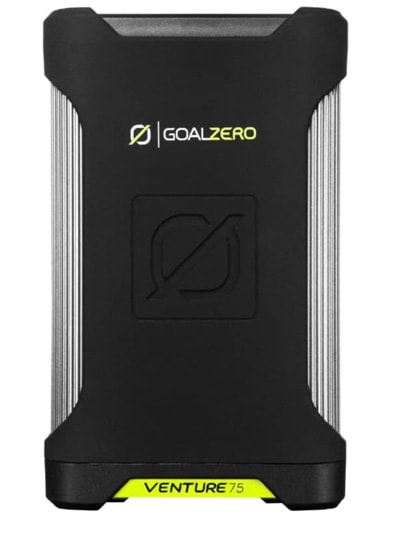
Movie / Music Downloads
Some trekkers arrive to the teahouses around 1-3pm each day. Having a few movies on your phone is good. If you like to listen to music as you go, make sure you have some good beats downloaded.
Other
Make sure to have copies of all your major documents plus your permits. I’d also recommend at least one trekking pole. Having one set of hand and toe warmers for the day you go over the pass is also helpful since it’ll be cold in the morning.
Trekking Poles
I used to hate trekking poles, but now I love them. They help make the hard days a little bit easier. You can rent some in Kathmandu for around $16 but I bought this pair on sale for $25, so it was worth the investment to just buy some.
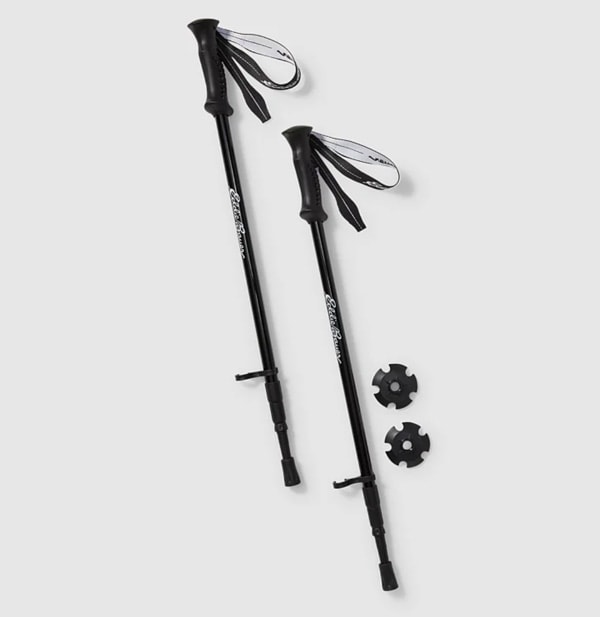
Money
Make sure to bring money in small denominations (500, 100, and 50) to make it easier for teahouse owners. If you only carry 1,000 rupee notes, it will be difficult to get change when you pay your bill.
Important Documents
You’ll want t have a copy of your passport, visa and your original trekking permits with you.
Entry Permit
The permit for the Annapurna Circuit can be bought in the Nepal Tourism Board office in Kathmandu. It’s about $30.
Travel Insurance
Have a copy of your trekking insurance with you. It’s worth considering getting travel insurance because you never know when something will go wrong. This route has no road access and rescues are done by helicopter which is expensive. Because of the altitude gains on this route and poorly written information telling people they can do the trek in three days, this route has a high helicopter rescue rate.
Sleeping Bag
I almost never recommend a sleeping bag, however, if you are a germaphobe, you may want to bring your own. Teahouses provide you with sheets and blankets, but they aren’t washed every day and are only washed by hand in cold water. We use the ones the teahouse provides but some people prefer their own.
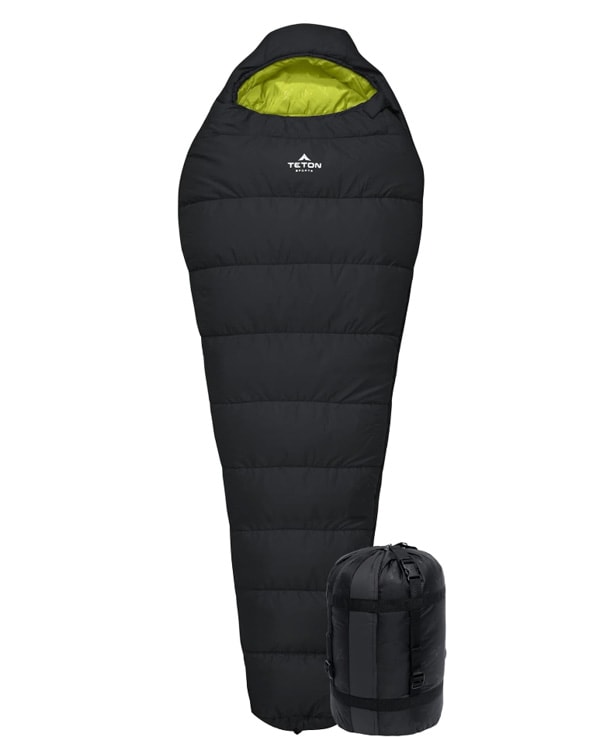
Crampons
It snowed a little when I did the AC in May, however, I’ve heard of blizzards happening over the pass. Crampons make it really easy to walk on snow or ice so you don’t slip and fall.
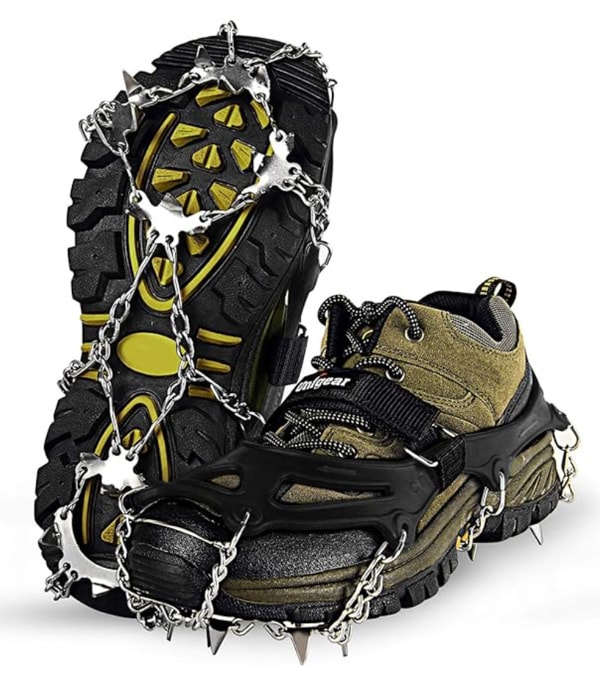
Map of the Area
I always keep a map of the area. It’s fun to take it out each night and go over tomorrow’s route, see the altitude gains, and plan lunch breaks. You can buy one in Kathmandu or Pokhara.
Playing Cards
Someone else will always have playing cards, but I recommend bringing a pack just in case. Learn a few games before you leave so you have some options to play when trekking. We had a hilarious time playing “Bullshit” with an entire teahouse. We also had an epic game of UNO going on one trek.
Duct Tape
This seems like a weird thing to recommend, but you never know when you’ll need it. Bring a small roll just in case. I once used it to keep a shoe from falling apart while walking back 5 hours after it busted open (a lesson in buying good quality shoes).
Chocolate
You can buy everything you need on this route, but chocolate is expensive. I recommend bringing some with you in case you need a little sugar to get moving.
Protein Bars
There are plenty of places to stop for snacks, but for some reason, it’s impossible to find protein bars or trail mix on the way. These are great for eating at tea breaks and in between meals.
Shopping in Nepal
Planning to shop when you arrive? On my first trip to Nepal, I was backpacking for 9 months in Southeast and South Asia. I didn’t have room in my pack to carry a bunch of heavy winter clothes with me, so I ended up buying everything in Thamel (the tourist hub in Kathmandu). I arrived a few days early, so I had plenty of time to search for things. I learned quickly that I’d need to check multiple stores and negotiate a lot.
Recently, I was approached by Mount Ready to try out their new system. They make the experience a lot easier. You simply go to their website, pick your trek and they have a pre-arranged pack with everything in it. It’s the same stuff you buy in Thamel (including knock offs) but you don’t have to spend days running around and negotiating. The prices are fair and you can add or remove stuff from the pack. You show up at the store, and everything is picked out for you. All you have to do is try it on and pick the colors you like. It’s super simple.
Before recommending them, I wanted to test it out myself, so I had them put together a pack for the Annapurna Circuit. I removed a few things, changed some sizes and styles and checked the quality of the clothes. If you’re doing a trek once and don’t want to invest a lot of money, then this is the way to go. I started out with a lot of items from Thamel and slowly upgraded my pack with the Eddie Bauer products listed above.
Annapurna Circuit Packing List Printout
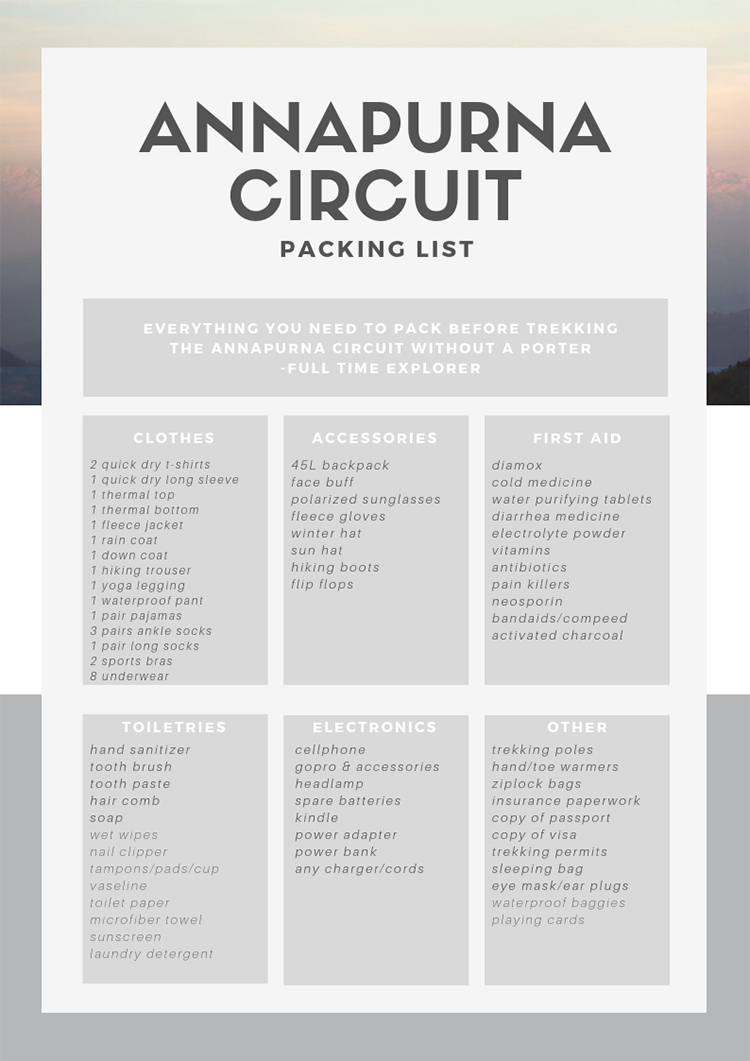
Have any questions about my Annapurna Circuit packing list? Ask me in the comments!
You might also like…
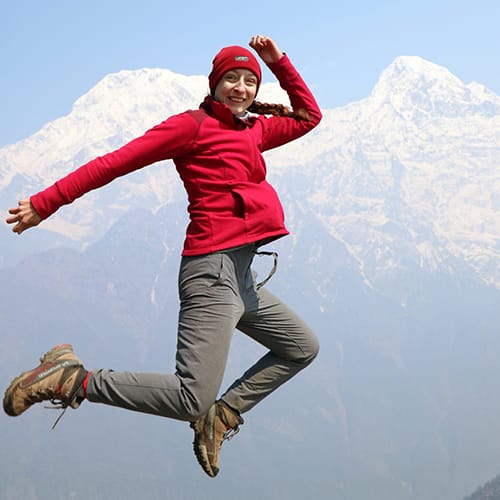
Michelle Della Giovanna
Writer at Full Time Explorer
I’m just your average New Yorker who quit her job in the fashion industry to explore the world. Come find out what it’s like to trade in five-inch heels for squat toilets.
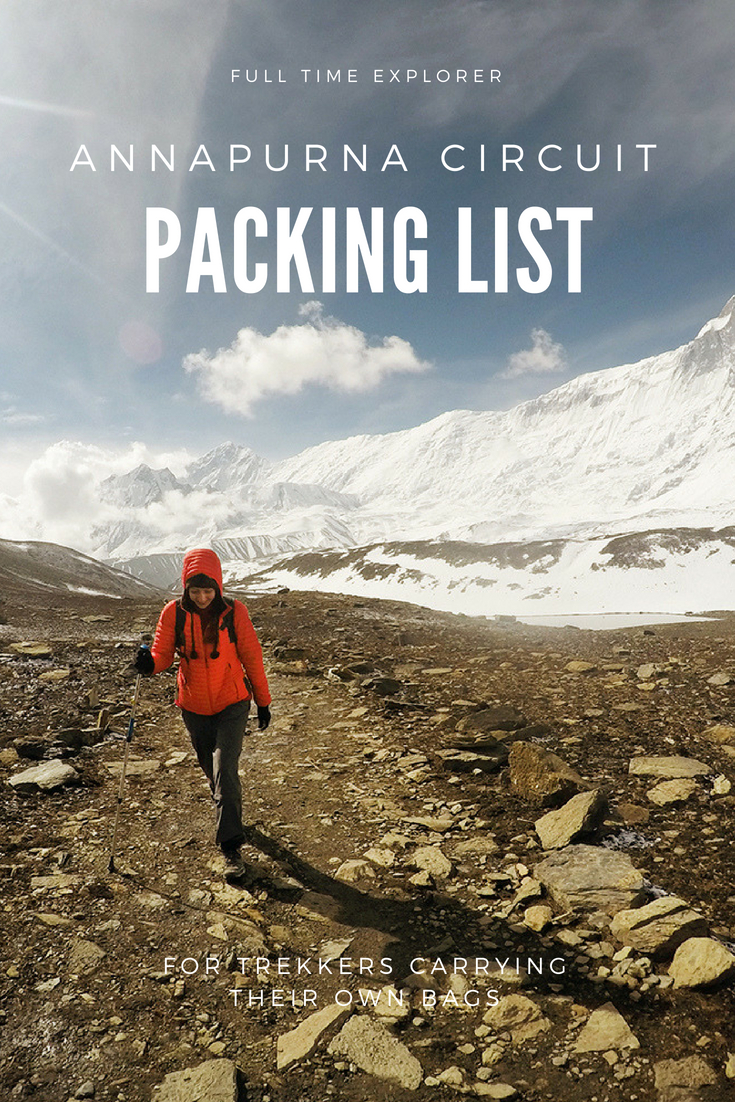

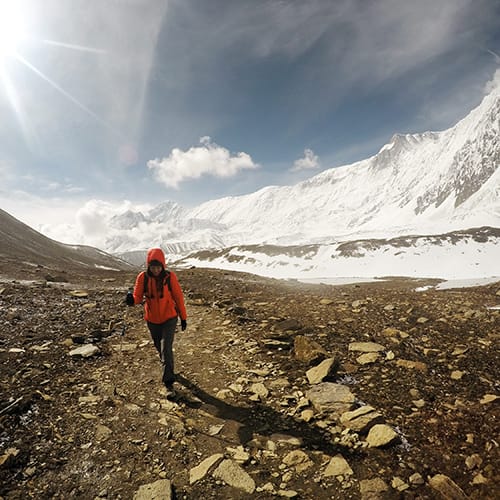
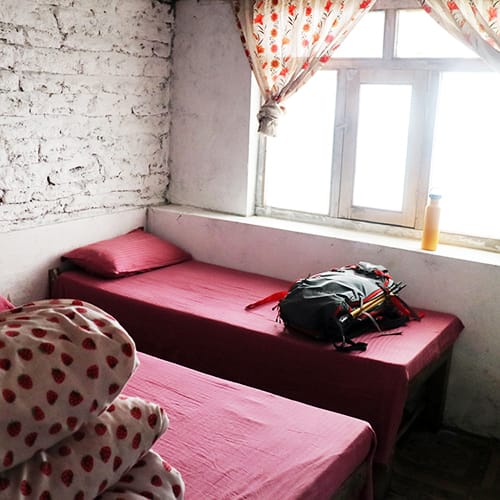
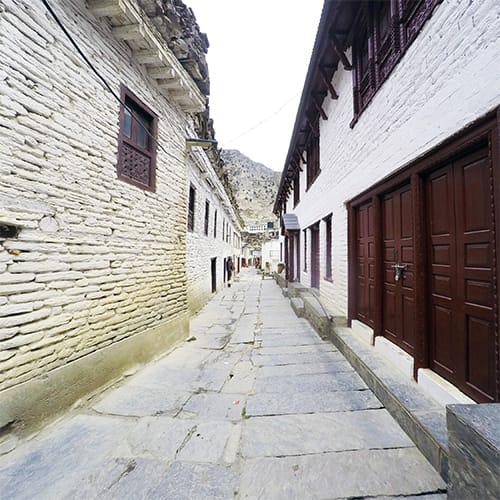
Hi, how big was your backpack? 40l or more? Thanks in advance!
Hey Paulina,
Mine was 40L which was a good size, but I went in May and didn’t need as many heavy layers or a sleeping bag. If you’ll be bringing a sleeping bag or a lot of heavy layers for fall/winter you may want a 50L.
Hello,
I’m going to nepal this october and plan to trek aswell. I more or less had the same packing list as you, do you know how much weighed your bag once it was fully packed ?
cheers,
nicolas
ps : planning to travel with a 45+10 backpack
I think it was around 20-25lbs. I had some extra things that I didn’t need and I removed them from this list so maybe it would be less
Hello,
I have a quick question that might sound silly 🙂 If one is travelling with a porter, am I assuming correctly that one pack their own backpack and the porter carries it? Asking for a friend.. 😉
Thank you in advance,
Ewa
Hi Ewa,
That’s not a silly question. If you are hiring a porter directly, then yes, you would pack your own backpack and give it to them to carry. If you are going with an expensive tour agency, sometimes they will provide a duffle bag that you use instead of your own.
Hope this helps your “friend” haha
Best,
Michelle